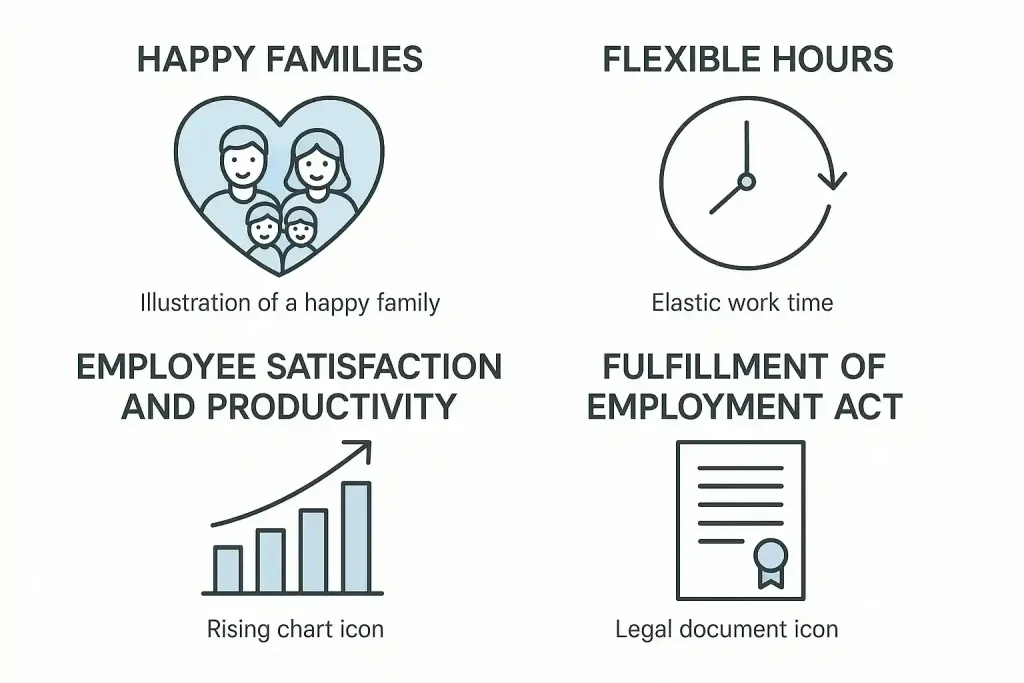3 Key Takeaways:
- Employers must recognize paternity leave as part of modern HR compliance to foster equality, retain talent, and align with the Employment Act 1955 updates.
- Eligibility criteria, leave duration, and application processes for fathers must be documented to avoid legal risks and confusion.
- SMEs and startups benefit from HR outsourcing to handle leave administration efficiently while focusing on business growth.
Although often misunderstood or mislabeled, maternity leave for fathers is more accurately known as paternity leave—a crucial provision in today’s evolving workplace.
For Malaysian employers striving to maintain fair and legally compliant HR practices, acknowledging paternity leave is no longer optional.
Hire us!
Elevate your business with tailored HR solutions, including compliance, talent acquisition, culture building, and streamlined processes. Unlock success today!

As the Employment Act 1955 continues to undergo important updates, SMEs and startups must keep pace to ensure that all employees, including fathers, receive the rightful leave they deserve under Malaysian labor law.
Why does this matter so much now?
It’s not just about ticking off compliance checkboxes—it’s about creating a balanced, inclusive work environment that retains talent, improves morale, and boosts productivity.
Fathers, just like mothers, play a vital role during the early stages of a child’s life.
Progressive companies are beginning to recognize the need for structured paternity policies, especially as expectations from younger workforces continue to shift.
Yet, confusion remains.
How many days of leave are allowed? Does it apply during probation? Who qualifies—and how should employers handle the documentation?
These questions aren’t just HR headaches—they represent potential legal and operational risks if mishandled.
This article breaks down the 10 core facts about maternity leave for fathers (paternity leave) that every employer in Malaysia should know—especially if you want to stay ahead of labor regulations and avoid unnecessary disputes.
Whether you’re managing a small business, building your first HR system, or already scaling and hiring expatriates, these insights will help you build compliant, future-ready policies.
Plus, we’ll include expert recommendations and real client testimonials from companies that have worked with MUSTRE.
An experienced HR outsourcing firm based in Shah Alam—to show how professional support can make the difference between confusion and clarity.
Let’s explore what every employer should know to ensure a smooth, fair, and fully compliant approach to paternity leave in Malaysia.
Key Benefits of What Are the 10 Core Facts About Maternity Leave for Fathers Every Employer Should Know?

Why This Matters for Employers & HR Teams
Understanding maternity leave for fathers isn’t just about regulatory compliance—it’s a core pillar of inclusive workplace culture.
Employers who proactively support paternity rights gain the trust and loyalty of their workforce.
- Compliance with Malaysian labor laws, including updates to the Employment Act 1955
- Better employee retention, especially among younger professionals starting families
- Positive brand image as a family-friendly employer
“Clear, fast, and professional communication. This HR service makes it very easy for us to manage salaries, holidays, etc. Thank you very much! There is no need to bother hiring HR staff. Outsource it!”
Nurul Atiqah Shamsudin
How These Core Facts Improve Workforce Planning and Policy
A clear understanding of paternity leave rules supports better decision-making in HR planning:
- Anticipate staffing needs during upcoming leaves
- Plan handovers and minimize operational disruptions
- Build policies aligned with actual legal entitlements
Additional Factors to Consider
- Labour law changes
- Social expectations
- HR system readiness
Common Challenges in What Are the 10 Core Facts About Maternity Leave for Fathers Every Employer Should Know?
What Are the Biggest Obstacles?
- Lack of awareness of updated legal requirements
- Poor documentation of paternity leave policies
- Unclear communication between HR, managers, and employees
“Win-win situation, staff and employer are both protected. If you want to learn on your own, it's really hard and slow, that’s why there is an HR team whose field is to manage the never-ending staff issues.”
Fatin Athifah Official
How to Overcome These Challenges
- Partner with HR outsourcing firms like MUSTRE
- Provide staff training on leave entitlements
- Automate leave requests via payroll software
“It’s the best, fast service. The staff are all very helpful. His boss is nice 😊”
Firza Ezryn
Best Practices for What Are the 10 Core Facts About Maternity Leave for Fathers Every Employer Should Know?

Actionable Tips for Success
- Include paternity leave in employment handbooks
- Set up early notice policies for expecting fathers
- Ensure parity in benefits for confirmed and probationary staff
“Thank God, MTR helps me manage my staff in a more organized manner and can produce productive staff.”
Anna Rosdijanti Ahmat Rusdi
Tools & Resources to Help You
- MUSTRE’s payroll system to track leave usage
- Employment law workshops to stay current
- HR documentation templates for SOPs
What Is the Difference Between Maternity and Paternity Leave?
Maternity leave is traditionally granted to mothers, while maternity leave for fathers, or paternity leave, provides time off for fathers to support their partners and newborns.
Malaysia now recognizes paternity leave in both public and private sectors (7 consecutive days minimum, depending on eligibility).
“Pn Mastura is very knowledgeable in HR... she knows how to speak to staff and stay neutral.”
Hafidz Khairudin
Why Employers Must Offer Statutory Paternity Leave
It’s no longer optional.
As of January 2023, private-sector fathers are legally entitled to 7 days of paid paternity leave—provided certain conditions are met.
Non-compliance may result in penalties or disputes.
What Is the Duration of Paid Paternity Leave in Malaysia?
The minimum is 7 consecutive days, and employers may voluntarily extend this duration as a benefit to attract and retain talent.
When Can Fathers Take Paternity Leave?
Fathers are expected to take their leave immediately following the birth of the child.
It must be utilized within 60 days of the birth date.
How to Ensure Eligibility: Employment Duration & Notification Requirements
To qualify:
- The employee must be legally married to the child’s mother
- Must have been employed for at least 12 months
- Must provide 30 days’ prior written notice to the employer
“Since using the service from MTR, matters related to staff are more managed… when there is a problem, MTR handles it professionally and calmly.”
Tengku Azrul Engku Chik
Which Fathers Qualify for Paternity Leave (Marital & Child Limits)?
Eligibility is limited to married male employees, and generally applies to up to 5 births per employee, based on company policy or mutual agreement.
Are There Differences Between Probationary and Confirmed Employees?
Confirmed employees are prioritized, but some employers offer flexibility.
It’s best practice to include clear terms in the employment contract or employee handbook.
Is Shared Parental Leave Available Between Parents?
As of now, Malaysia does not provide shared parental leave legally.
However, progressive companies can create internal benefits or unpaid leave options.
How Employers Should Document and Process Paternity Leave

- Use standardized leave forms
- Maintain a leave register
- Integrate the process with your payroll system
“MTR consistently handles our payroll with dedication and accuracy... addressing queries about salary structures and policies.”
drnaz
What Support Beyond Statutory Leave Should Employers Offer?
Forward-thinking companies go beyond compliance:
- Flexi-hours after return
- Additional unpaid days
- Workshops for new fathers
- Mental health support
“Alhamdulillah met MTR. Fast service and a very experienced team. Ms. Mastura gives advice to help us become good employers.”
Dahlia Naz
Strengthening HR Compliance Through Awareness
Paternity rights are no longer a luxury—they are a necessity in a modern, compliant, and inclusive workplace.
By understanding these 10 core facts about maternity leave for fathers, employers can avoid legal pitfalls, boost employee morale, and promote a healthy work-life balance for all.
Whether you run a growing SME or a new startup, proactive HR policies on fatherhood leave are a key to building trust and loyalty in your organization.
If you’re unsure how to align your policies with the latest updates on maternity leave for fathers, let MUSTRE guide you.
Our team specializes in HR compliance, payroll, and employee documentation that keeps your business on track.
From contract drafting to staff briefings and policy setup, we help employers stay compliant—while freeing your time to grow your company.
🟢 Whatsapp Now for a free HR consultation and policy review.
Frequently Asked Questions (FAQ)
1. What does maternity leave for fathers cover in Malaysia?
Maternity leave for fathers, often referred to as paternity leave, covers a minimum of 7 consecutive days of paid leave for eligible male employees.
This allows fathers to support their spouse and newborn immediately after childbirth.
2. How can SMEs manage maternity leave for fathers efficiently?
SMEs can streamline paternity leave by:
- Including it in employment handbooks
- Using payroll software to track usage
- Outsourcing HR services like MUSTRE for compliance and documentation
3. Can probationary employees apply for maternity leave for fathers?
Generally, paternity leave applies to confirmed employees.
However, some companies extend this benefit to probationary staff at their discretion.
Clear policy documentation is essential.
4. What role does HR outsourcing play in managing leave policies?
HR outsourcing firms like MUSTRE provide:
- Legal policy templates
- Leave management systems
- Staff briefings and advisory to prevent missteps in compliance
5. Is maternity leave for fathers applicable for adoptive parents?
Currently, Malaysia’s statutory paternity leave does not explicitly cover adoptive fathers.
However, employers may offer discretionary leave to support adoptive families as part of internal policies.











